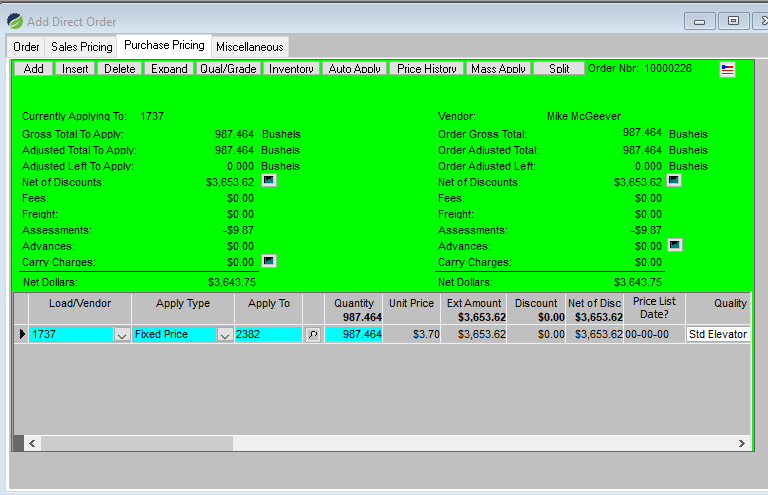Doing Directs Directly
When merchandising grain, it is not uncommon to set up a purchase and sale where you ship directly from the buyer to the seller without ever taking physical possession of the grain. Sometimes called a direct order, or a back-to-back, or a scalp transaction, these transactions allow traders to earn money by facilitating the transfer of grain and by arranging the freight.
Most systems accomplish directs by creating a separate purchase and sale transaction, and then linking them together. This requires the same information to be stored on two sets of transactions and can lead to headaches when the data isn’t kept in synchronization. As the old data processing joke goes:
Parallel files, aren’t.
In Agrosoft, we avoid this problem by recording the purchase and sale as a single transaction, thus eliminating the need for dual data entry and the possibility of parallel transactions getting out of synchronization.
This is our screen for entering director orders. In this example, we are purchasing/selling a truck of grain. Note that we record both the origin (shipment) of the grain, as well as the destination (receipt) of the grain on the same screen. Since this information is recorded in one place, recording the receipt of the grain on this screen marks the transactions as received on both the purchase and sales sides.

In the example above, we only record one truck's shipment. But the grid structure allows us to set up many loads on a single order if we dare to.
We have separate tabs that allow you to record the sales pricing:

As well as the purchase pricing:

One key advantage of this approach is you are not setting up separate transactions with duplicate information, and when you record the shipment (or receipt) of the grain you record it in only one place. Similarly, you can record your freight information in a single place, and not waste time rekeying the freight across two transactions.
Although the direct is a separate transaction the sale can be invoiced before the purchase is recorded as complete, or visa-versa. So you can invoice grain even though the purchase is still unpriced.
Yet another advantage of this is inventory management. Systems that require you to set up separate purchases and sales will typically require you to set up a dummy “direct” location, to avoid recording the physical receipt of inventory that you never have. In Agrosoft, you can record the direct at the location responsible for establishing the direct, without ever impacting physical inventory.
Setting up a dummy “direct” location can also create costing problems. If you have several directs being shipped & received at the same time, the costs of the inventory can become intermingled, which distorts the margin on each individual sale. With Agrosoft, there is no dummy location, and you can easily compare the purchase price to the sales price on every transaction.
Conclusion
Why do transactions twice when you can do them once, correctly, without errors, and without kludges or workarounds for “hiding” the fact that you aren’t receiving physical inventory? Agrosoft allows you to record directs as directs, once, and with the correct margins and inventory.
